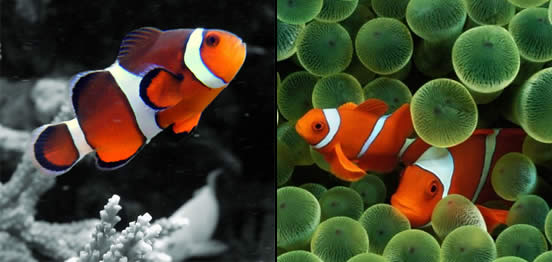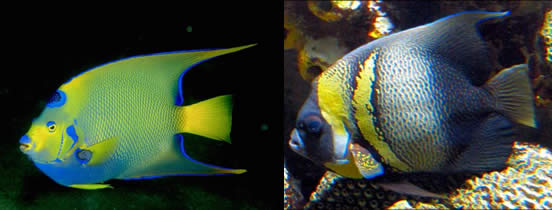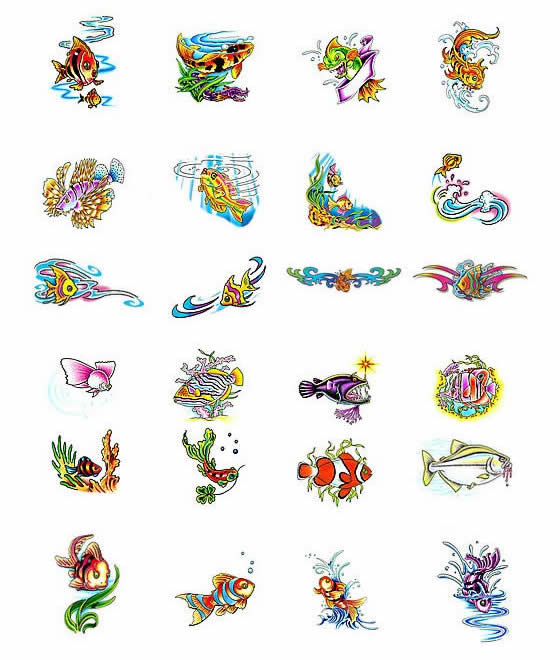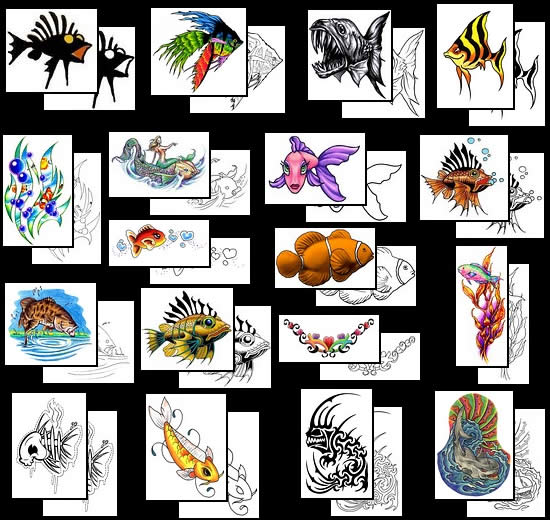|
|
|||
 |
|||
|
TATTOO DESIGNS & SYMBOLS - FISH TATTOOS
Tattoo Symbol Index - A B C D E F G H I J K L M N O P Q R S T U V W X Y Z Tattoo designs - F >> Fish Tattoos Fish Tattoo Meanings - Fish shrines dating back to 6000 BC in Northern Europe make it one of the most ancient symbols known to man. Around 2500 BC, the fish symbol appeared on pottery in India, reflecting the popularity of the fish deity.
Two fish, swimming in opposite directions, is, of course, the sign of watery Pisces.
Well before the appearance of our major religions, the pointed oval sign known as vesica piscis (Latin for 'fish bladder') was linked with fertility and the feminine life force. During the early Christian era, the fish was adopted as a secret code during times of persecution. Christians scratched the fish-like icon in the dust or on walls, identifying the location as a safe haven -- here was a place where they could meet without fear of betrayal. Later, this symbol was incorporated into the ritual and décor of the church. This same simple geometric motif is known as ichthus, the Greek word for fish, and has become a symbol for Jesus. It is used to declare an affiliation with the Christian Faith. It's seen on car decals and hanging from key chains and charm bracelets. Evolutionists inscribe the word 'Darwin' or 'Evolve' inside that pointed oval, which, to some Americans, resembles a football.
For aboriginal and indigenous peoples of the world - particularly in coastal regions -- the fish was a bountiful food source and powerful animal totem. No fish was more revered and mythologized than the salmon, symbol of abundance, fertility, and wealth. On a more mystical level, the salmon was -- and still is -- admired for its instinct and persistence, and for the determination it shows in its heroic journey upriver from the ocean to its spawning grounds, often located many hundreds of miles up freshwater rivers. The miracle of its migration to spawn and die has made it a revered symbol of courage, tenacity, steadfastness and dependability. For the Haida people, the salmon meant prosperity and the flourishing of the tribe or clan. It appears in totemic carvings beneath the great Thunderbird and Raven. Myth relates how the Raven was dispatched to seek the great fish, after the Haida chief's daughter had seen the salmon in a dream. The Raven lured the salmon to river inlets where the oil-rich sockeye swarmed in such numbers that it was said you could walk across the river on their backs. The rest is history as the Haida and the Salmon became integral to each other's existence.
Celtic myth relates how the salmon became the symbol of wisdom after swallowing sacred hazel nuts at the site of the well of knowledge. Eating salmon was associated with gaining wisdom. Perhaps the beginning of the theory that eating fish is good for your brain! Because it lived in the ocean - the realm of mystery and the unknown - it also came to symbolize the unconscious, inspiration and prophecy.
The New Zealand Maori have a special reason to revere the fish -- their North Island resembles one. According to legend, the god 'Maui' fished it into being. A birds-eye view reveals clearly how the northern tip of the island resembles the tail of Maui's fish, and Wellington Harbour the mouth. As for the South Island, it's Maui's canoe, and Stewart Island, the anchor. In Australia, the rainbow was an ancestral spirit, part fish, which resided in deep water holes. Bark paintings depict the fish symbol as representing water and transformative power. One of the most significant and powerful fish totems was - and still is - the shark.
To the Western mind, the shark is often associated with negative values for its reputation as fierce predator in nature. It carries the connotation of greed, danger and deceit. However, for indigenous peoples whose traditional livelihood was based on hunting and gathering, a profound understanding of wildlife was a part of their spiritual and religious practice. For that reason, the shark's talents were recognized and emulated rather than feared. Polynesians and Australian Aborigines for example, take the shark as a symbol of their connection to the sea, and as a link to the values of their ancestors.
Fish with totemic attributes were not to be eaten, however, especially if the fish in question was an 'ancestor' god. Among some Polynesian groups, the eel was such a fish. It was also a symbol of 'justified revenge' and was prayed to by those hoping to mete out justice to an enemy.
Freshwater fish play an important role in many Asian cultures as entities to ward off evil spirits, or to bring harmony and prosperity into the home. The fish is the water symbol, an essential element in Chinese 'feng shui'. The carp (goldfish) is synonymous with good fortune, while a carp leaping over a wave is the symbol of man's ability to transcend. The carp is leaving the lower regions and 'jumping' to a higher ground of being. The carp also represents longevity, wisdom, loyalty and knowledge, and is a popular creature in Chinese mythology. The Golden Dragon Fish - a favourite aquarium fish, native to Malaysia and Indonesia - is admired for its resemblance to the mythological dragon, symbol of prosperity and good luck. Other popular favourites are the multi-coloured koi fish, symbol of perseverance and success in adversity. In Chinese mythology, the koi had the ability to climb waterfalls and transform into a dragon.
In the sports fishing world, the two fish that provide the most 'sport' are the sailfish and marlin. Mexico, Cuba, the Caribbean, Florida and Kenya are popular destinations for serious fishing expeditions. When hooked, these two mighty fish put up a spectacular fight, leaping clear of the water and running at great speeds. Ernest Hemingway helped launch the marlin to superstar status in his Nobel Prize winning novel, The Old Man and the Sea. Though Hemingway himself avoided any claim to symbolism, saying it was a simple story about a man and a fish, anyone who wants to probe our collective unconscious will find it rich in symbolism. The Christian symbolism of suffering and redemption are attributed to the journey of the old man and the great fish. In the struggle to land the marlin, the fish becomes the symbol for endurance and courage, just the qualities the man must prove if he's going to keep the marlin, once he hooks it. At the story's end, a fish skeleton is all the old man has for his efforts. The sharks that devour the marlin on the return journey are symbols of modern man's insatiable greed and the disrespect for the traditional ways represented by the old man.
See also: Marine Life Tattoo Index Choose your own fish tattoo design from Tattoo-Art.com. Buy the fish tattoo design that is perfect for you. Get your Fish Tattoos and design ideas from Tattoo Johnny Tattoo designs - F >> Fish Tattoo Symbol Index - A B C D E F G H I J K L M N O P Q R S T U V W X Y Z |
||
| Celeb Tattoos | Facts & Stats | Designs & Symbols | History | Culture | Links | Tattoo Galleries | Contact | |||
|
|
|||














